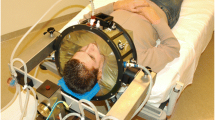Abstract
The potential of proton microchannel radiotherapy to reduce radiation effects in the healthy tissue but to keep tumor control the same as in conventional proton therapy is further elucidated. The microchannels spread on their way to the tumor tissue resulting in different fractions of the healthy tissue covered with doses larger than the tumor dose, while the tumor gets homogeneously irradiated. The aim of this study was to evaluate the effect of increasing channel width on potential side effects in the normal tissue. A rectangular 180 × 180 µm2 and two Gaussian-type dose distributions of σ = 260 µm and σ = 520 µm with an interchannel distance of 1.8 mm have been applied by 20-MeV protons to a 3D human skin model in order to simulate the widened channels and to compare the irradiation effects at different endpoints to those of a homogeneous proton irradiation. The number of protons applied was kept constant at all irradiation modes resulting in the same average dose of 2 Gy. All kinds of proton microchannel irradiation lead to higher cell viability and produce significantly less genetic damage than homogeneous proton irradiation, but the reduction is lower for the wider channel sizes. Our findings point toward the application of microchannel irradiation for clinical proton or heavy ion therapy to further reduce damage of normal tissues while maintaining tumor control via a homogeneous dose distribution inside the tumor.






Similar content being viewed by others
References
Anschel DJ, Bravin A, Romanelli P (2010) Microbeam radiosurgery using synchrotron-generated submillimetric beams: a new tool for the treatment of brain disorders. Neurosurg Rev 34(2):133–142. doi:10.1007/s10143-010-0292-3
Brauer-Krisch E, Bravin A, Lerch M, Rosenfeld A, Stepanek J, Di Michiel M, Laissue JA (2003) MOSFET dosimetry for microbeam radiation therapy at the European Synchrotron Radiation Facility. Med Phys 30(4):583–589. doi:10.1118/1.1562169
Brauer-Krisch E, Requardt H, Regnard P, Corde S, Siegbahn E, LeDuc G, Brochard T, Blattmann H, Laissue J, Bravin A (2005) New irradiation geometry for microbeam radiation therapy. Phys Med Biol 50(13):3103–3111. doi:10.1088/0031-9155/50/13/009
Greubel C, Hable V, Drexler GA, Hauptner A, Dietzel S, Strickfaden H, Baur I, Krucken R, Cremer T, Friedl AA, Dollinger G (2008) Quantitative analysis of DNA-damage response factors after sequential ion microirradiation. Radiat Environ Biophys 47(4):415–422. doi:10.1007/s00411-008-0181-0
Hauptner A, Dietzel S, Drexler GA, Reichart P, Krucken R, Cremer T, Friedl AA, Dollinger G (2004) Microirradiation of cells with energetic heavy ions. Radiat Environ Biophys 42(4):237–245. doi:10.1007/s00411-003-0222-7
Laissue JA, Blattmann H, Wagner HP, Grotzer MA, Slatkin DN (2007) Prospects for microbeam radiation therapy of brain tumours in children to reduce neurological sequelae. Dev Med Child Neurol 49(8):577–581. doi:10.1111/j.1469-8749.2007.00577.x
Reinhardt S, Hillbrand M, Wilkens JJ, Assmann W (2012) Comparison of Gafchromic EBT2 and EBT3 films for clinical photon and proton beams. Med Phys 39:5257–5262. doi:10.1118/1.4737890
Schmid TE, Dollinger G, Hable V, Greubel C, Zlobinskaya O, Michalski D, Molls M, Roper B (2010) Relative biological effectiveness of pulsed and continuous 20 MeV protons for micronucleus induction in 3D human reconstructed skin tissue. Radiother Oncol 95(1):66–72. doi:10.1016/j.radonc.2010.03.010
Serduc R, Christen T, Laissue J, Farion R, Bouchet A, Sanden B, Segebarth C, Brauer-Krisch E, Le Duc G, Bravin A, Remy C, Barbier EL (2008) Brain tumor vessel response to synchrotron microbeam radiation therapy: a short-term in vivo study. Phys Med Biol 53(13):3609–3622. doi:10.1088/0031-9155/53/13/015
Slatkin DN, Spanne P, Dilmanian FA, Gebbers JO, Laissue JA (1995) Subacute neuropathological effects of microplanar beams of X-rays from a synchrotron wiggler. Proc Natl Acad Sci USA 92(19):8783–8787
Ziegler JF, Biersack JP (2003) The stopping and range of ions in matter (SRIM2003) [online]. http://www.srim.org
Zlobinskaya O, Girst S, Greubel C, Hable V, Siebenwirth C, Walsh DWM, Multhoff G, Wilkens JJ, Schmid TE, Dollinger G (2013) Reduced side effects by proton microchannel radiotherapy: study in a human skin model. Radiat Environ Biophys 52:123–133. doi:10.1007/s00411-012-0450-9
Acknowledgments
This work was supported by the DFG Cluster of Excellence “Munich-Centre for Advanced Photonics,” by EU FP7 DoReMi Network of Excellence and by the Maier Leibnitz Laboratory Munich. We thank Sabine Reinhardt for her support with the Gafchromic film dosimetry and the staff of MLL operating the tandem accelerator.
Author information
Authors and Affiliations
Corresponding author
Rights and permissions
About this article
Cite this article
Girst, S., Greubel, C., Reindl, J. et al. The influence of the channel size on the reduction of side effects in microchannel proton therapy. Radiat Environ Biophys 54, 335–342 (2015). https://doi.org/10.1007/s00411-015-0600-y
Received:
Accepted:
Published:
Issue Date:
DOI: https://doi.org/10.1007/s00411-015-0600-y




